Turmeric Tea Recipe (with Ginger and Lemon) – Tastier than tea bags!
A soothing, feel-good Turmeric Tea recipe that tastes better, livelier than tea bags. This recipe is optimized for absorption and works with both fresh turmeric root and powder. Includes a concentrate recipe and a no-brew option for on-the-go cups! Tested to perfection!
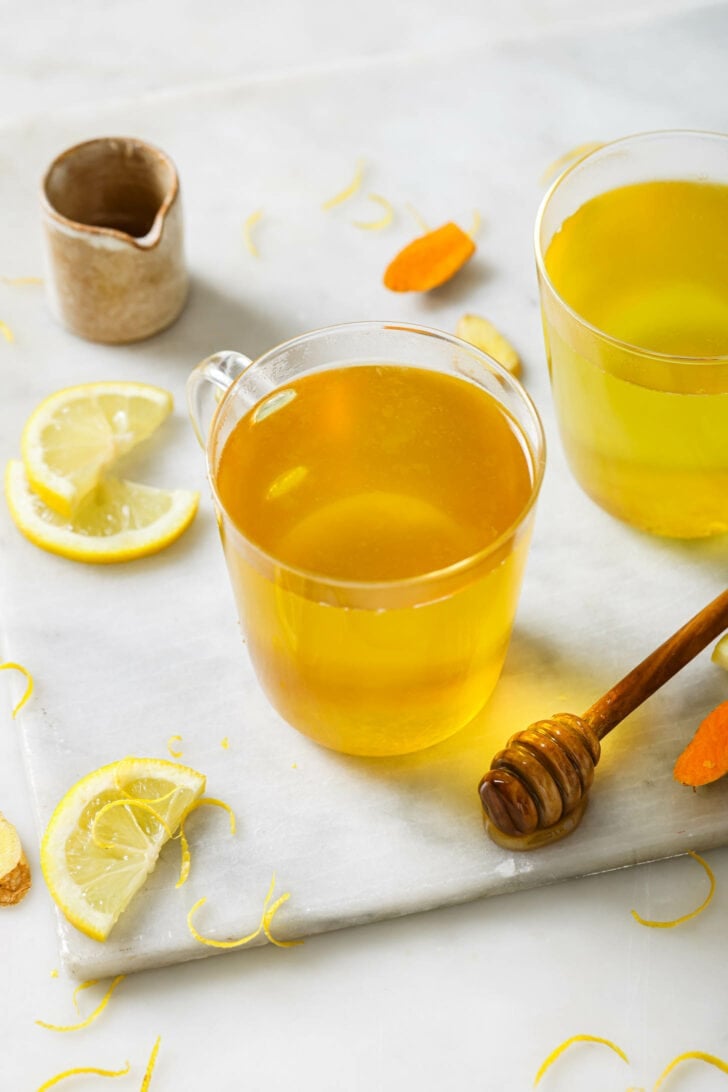
Want to save this post?
Enter your email below and get it sent straight to your inbox. Plus, get recipes & tips every week!
Turmeric Tea
This Turmeric Tea recipe has everything you need and nothing you don’t. This recipe:
- Requires no peeling or grating of the turmeric and ginger. You’re just thinly slicing to extract their flavor with minimal work.
- Is balanced in taste. No weak flavors, but not overpowering or unpalatable.
- Is optimized for absorption with a touch of black pepper.
- Includes on-the-go options, no stovetop required. So you can make a concentrate or steep in your cup!
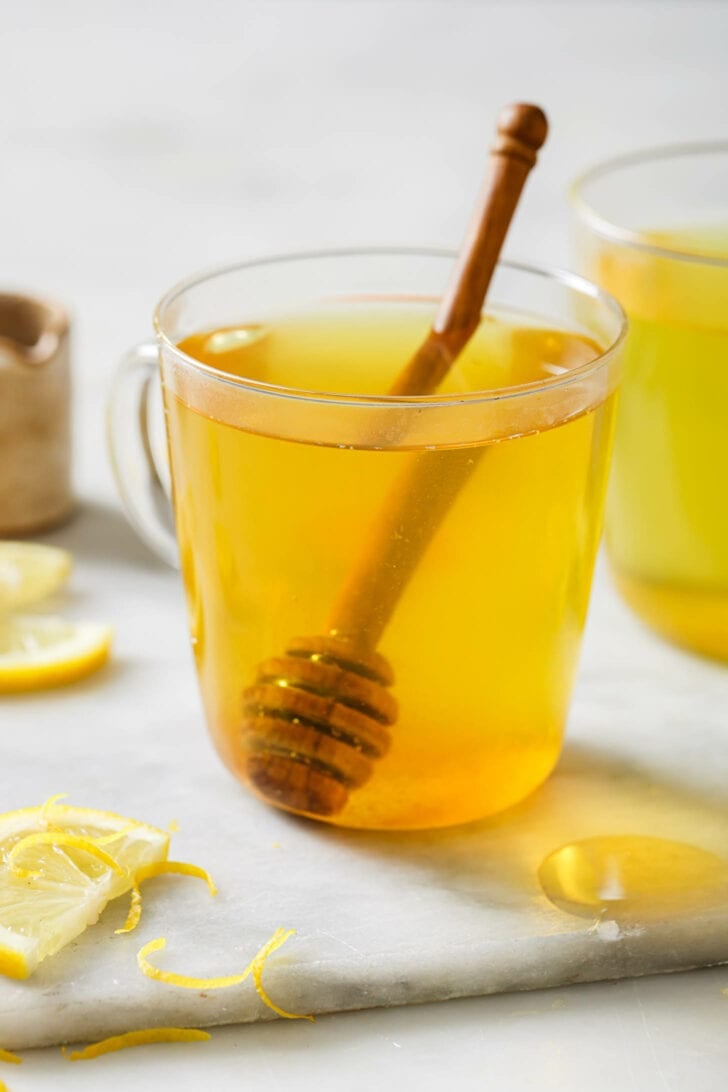
I’ve been around turmeric all my life. As a teenager, I’d see my grandparents mix it into their daily morning concoction. When I started to cook, I realized how essential it is for transforming pale curries into something vibrant and appetizing. If you try making Zucchini Curry without turmeric, you’ll know what I mean. And now, turmeric in some form is standard protocol when anyone in the house is sick.
Turmeric Tea is Turmeric Milk‘s lighter, more convenient counterpart. (As far as I know, water-based Turmeric Tea is not popular in India or Pakistan.) After trying a couple of tea bags, I discovered that turmeric in tea form can be soothing, nourishing, and even tasty. So I recreated those tea bag flavors, but with bright, fresh ingredients. You will taste the difference immediately.
Ingredients + Preparation
Turmeric
Turmeric is an ancient Indian plant that belongs to the ginger family. To make turmeric powder, farmers clean, boil, dry, and grind turmeric rhizome (this Youtube video shows the process).
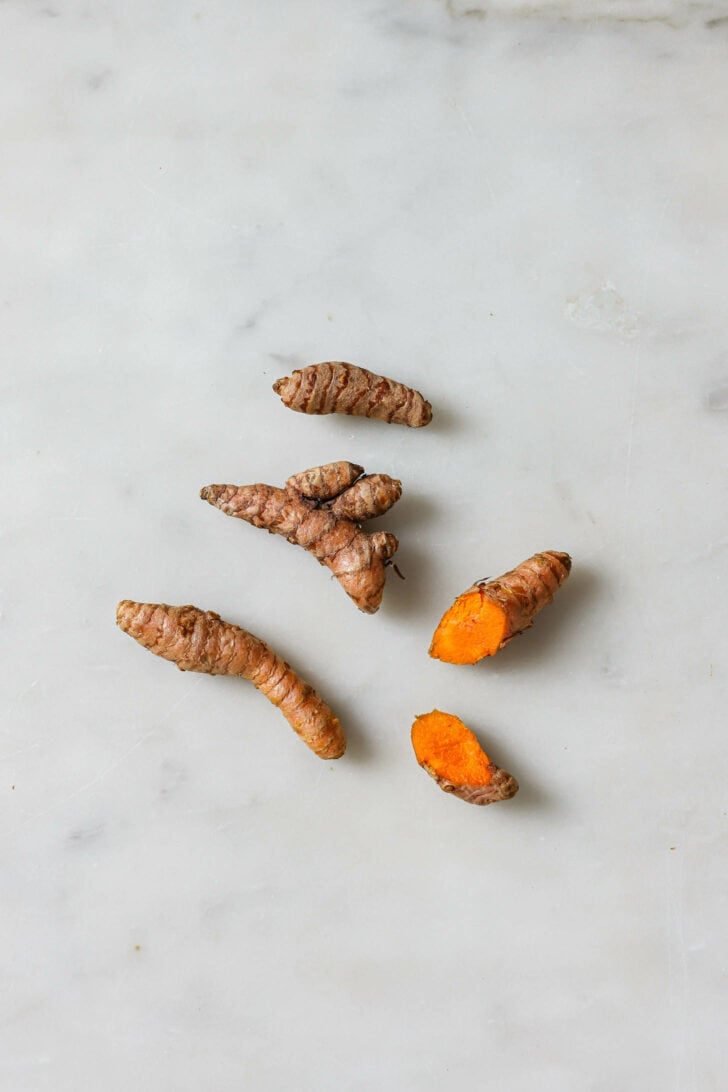
Using Root vs Powder
Interestingly, save for the occasional Turmeric Achar (pickle), you’ll rarely find turmeric root used in Desi cooking. Instead, people use ground turmeric in almost everything – curries, snacks, breads, and drinks.
Traditional turmeric tea recipes usually pair turmeric powder with milk, not water. Perhaps this is because curcumin (turmeric’s active compound) is fat-soluble and better absorbed with milk, or because turmeric powder is just more palatable with milk. (Notice that as much as we use it, you can hardly taste turmeric in curries.)
Since this is a water-based tea, I prefer to make it with turmeric root. It gives cleaner, more vibrant flavor compared to turmeric powder.
That said, turmeric powder works just as well. The key is to use a small amount, 1/8 teaspoon at most. Remember, though turmeric is well tolerated, more is not necessarily better. Using too much will make it taste medicinal and murky.
Where to find: Turmeric root is increasingly easier to find. I see it often at my local grocery store, and I know Whole Foods usually carries it.
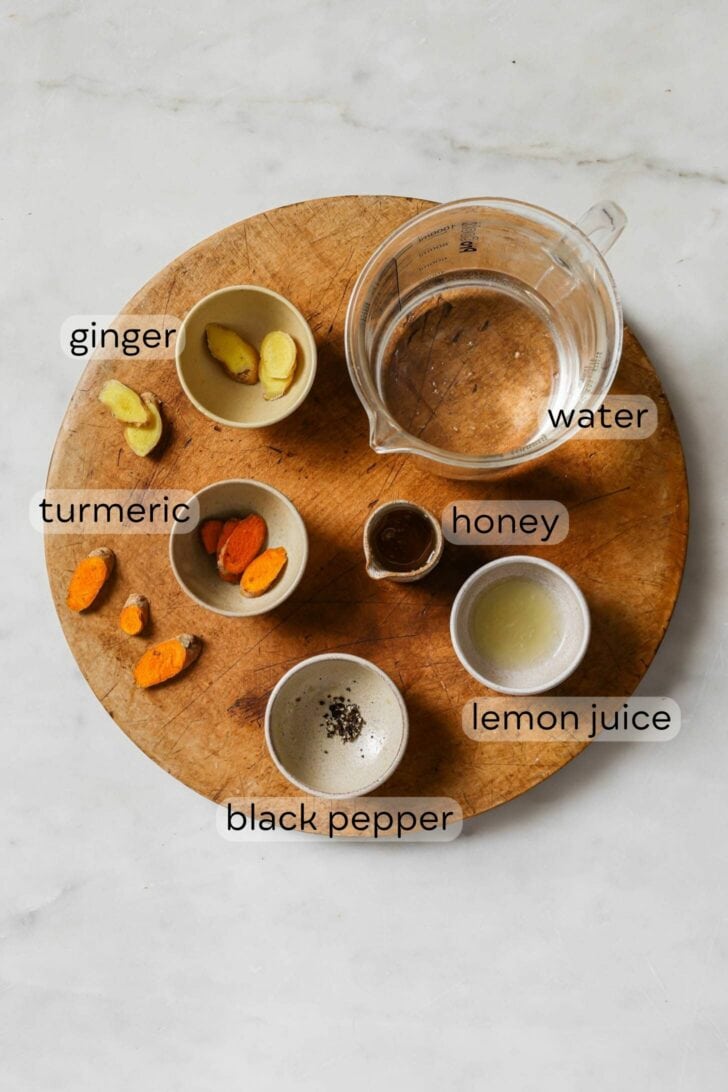
Other Ingredients
- Water: Like my Masala Chai and Turmeric Milk, this recipe accounts for evaporation. You’re starting with 2 cups so that you can end up with around 1 1/2 cups/12 oz (about the size of most large mugs).
- Fresh ginger root: Ginger can be overpowering compared to turmeric. As a general guideline, I’d suggest using twice as much turmeric as ginger.
Note on slicing the turmeric and ginger: The reason I thinly slice is because grating them by hand is tedious (I don’t even grate ginger for curries). You can also lightly crush them both with a mortar & pestle which also works just as well, with a little more debris.
- Freshly ground black pepper: Piperine (the compound in black pepper that enhances turmeric absorption) makes black pepper an essential ingredient if you’re aiming to get the most health benefits. Just a small amount is enough. I like to use my pepper grinder, as pre-ground black pepper may have lost its beneficial properties.
- Freshly squeezed lemon juice: Helps cut the natural bitterness of the ginger and turmeric.
- Honey (optional): Unlike Turmeric Milk, Turmeric Tea doesn’t really beg for a sweetner. If it’s your first time trying it, honey makes it more appealing.
How to make Turmeric Tea
Here’s the simple step-by-step:
- Pour the measured water into a small saucepan or pot and bring to a simmer over medium-high heat. (I get the water started in my kettle.)
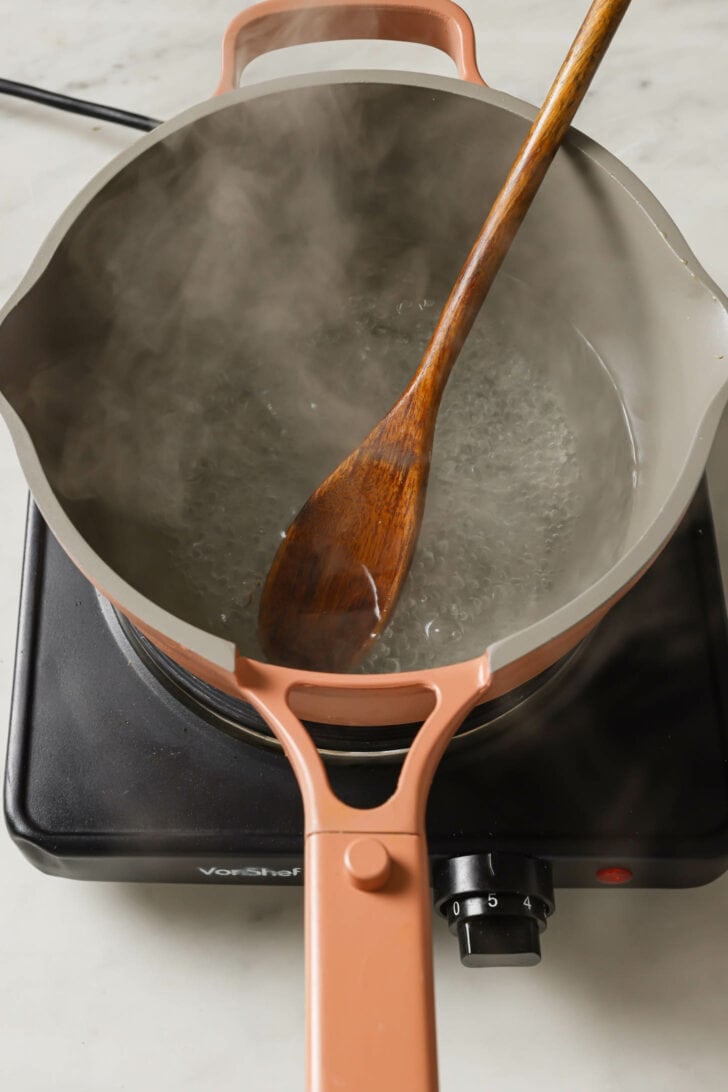
- Add the turmeric, ginger, and black pepper and simmer for 5-10 minutes, depending on how strong you’d like the steep. Don’t worry about boiling for too long – studies have shown turmeric retains its beneficial properties when boiled. The color will deepen the longer you simmer.
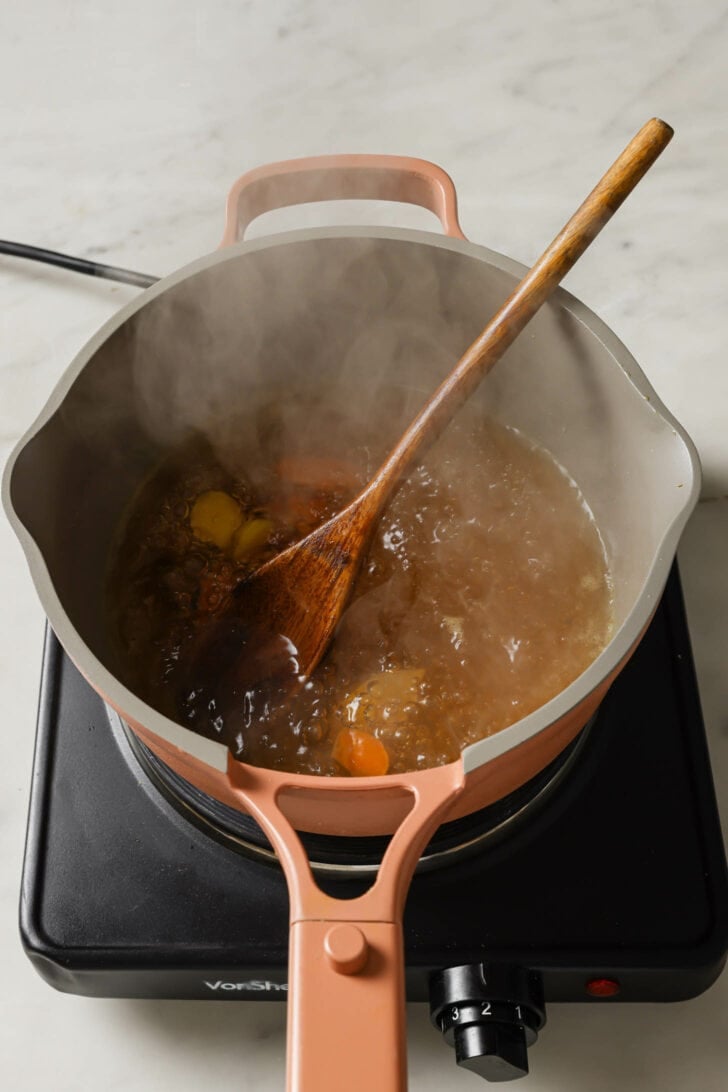
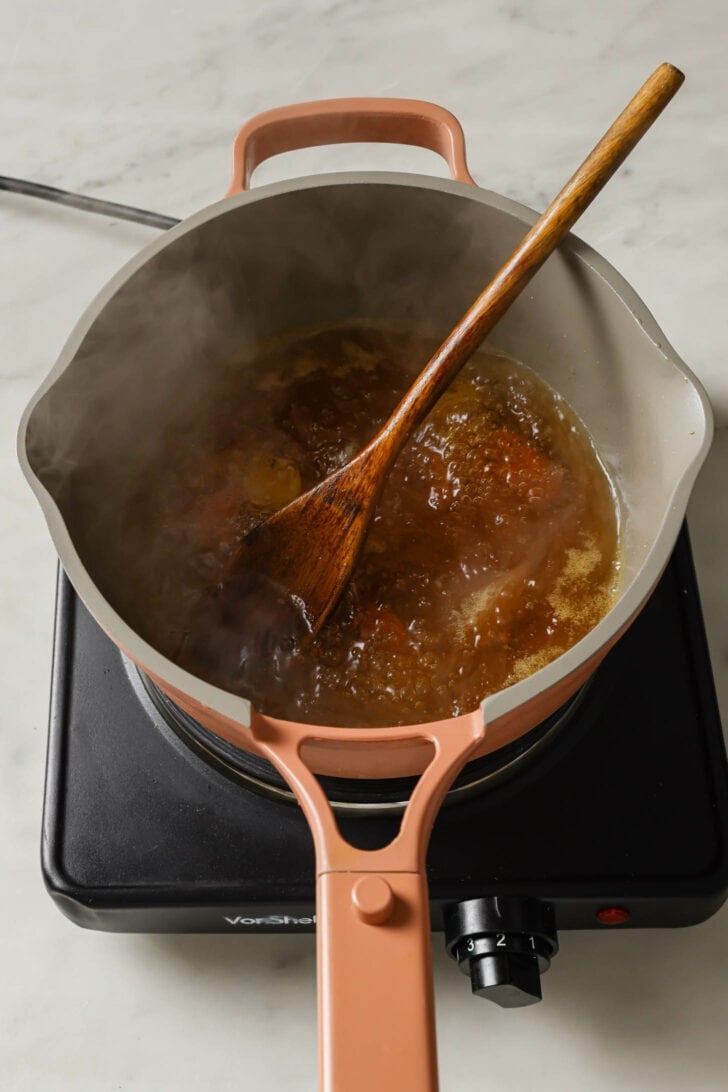
- Strain the tea through a fine sieve into your cup.
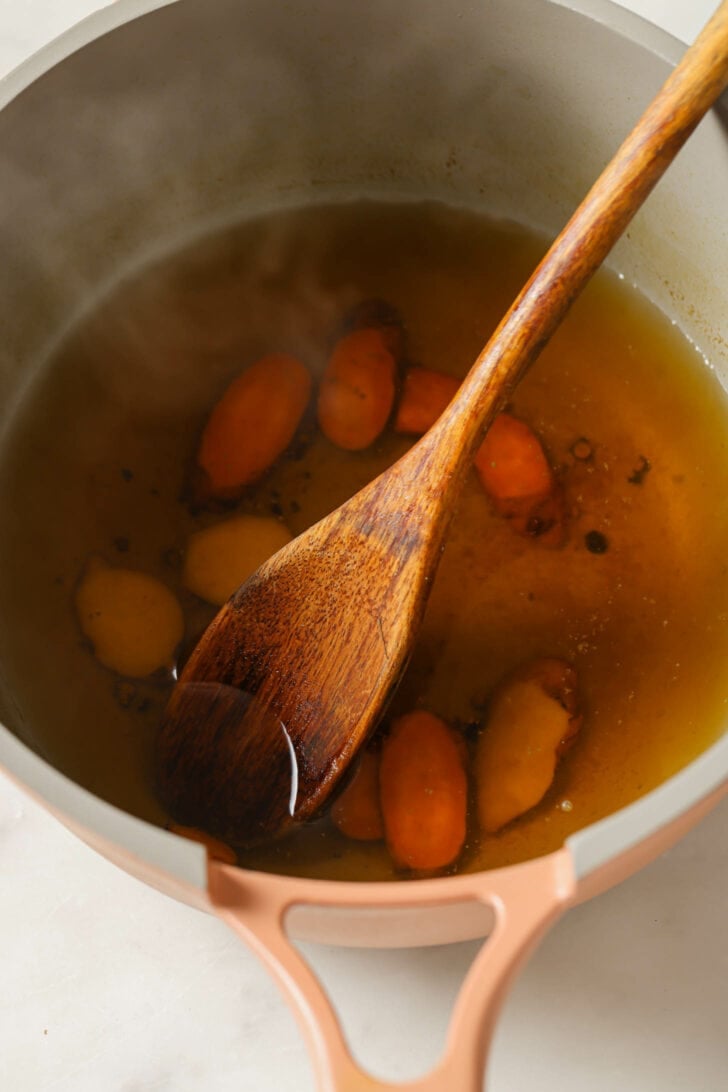
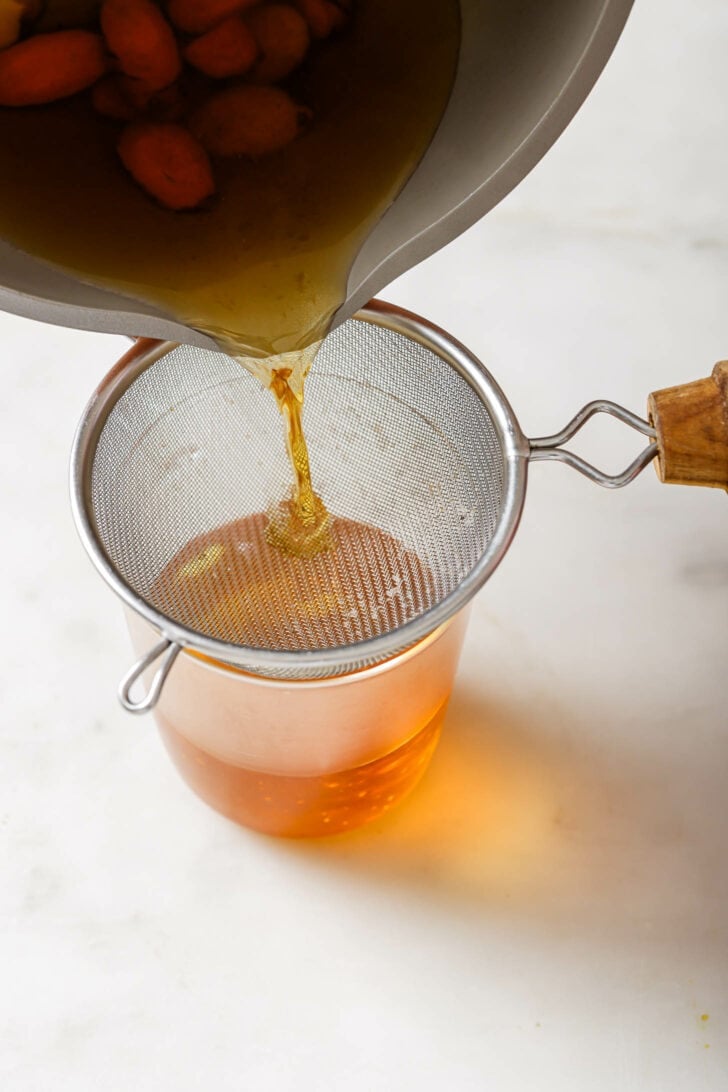
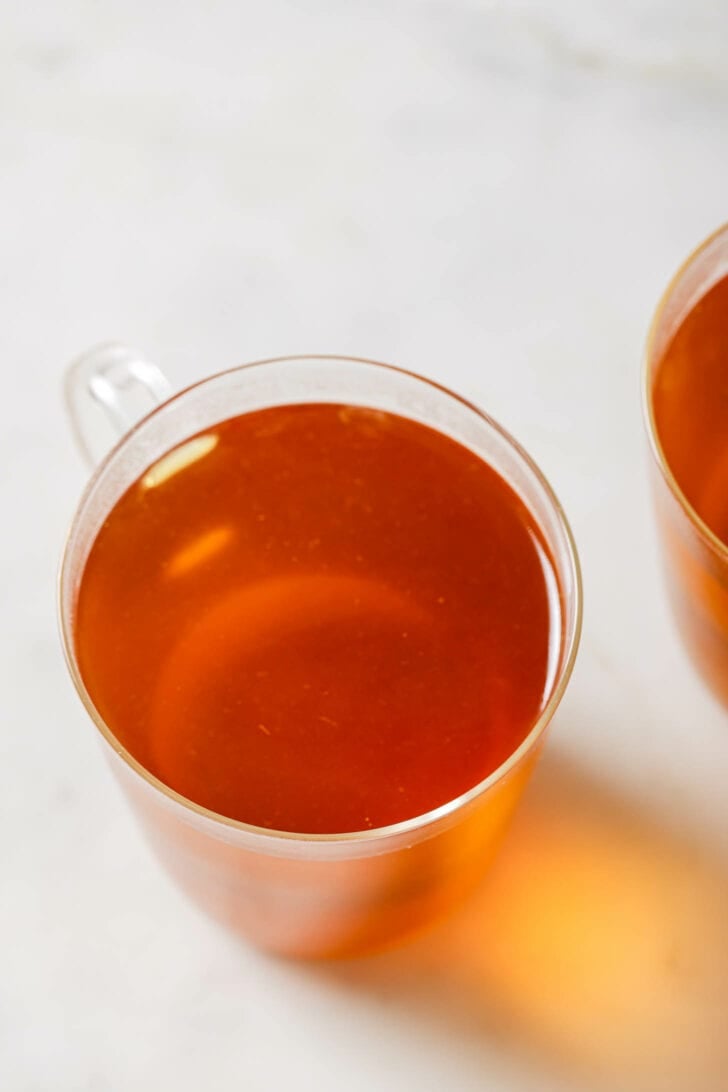
- Squeeze in the lemon juice. The color will lighten depending on how much lemon you add.
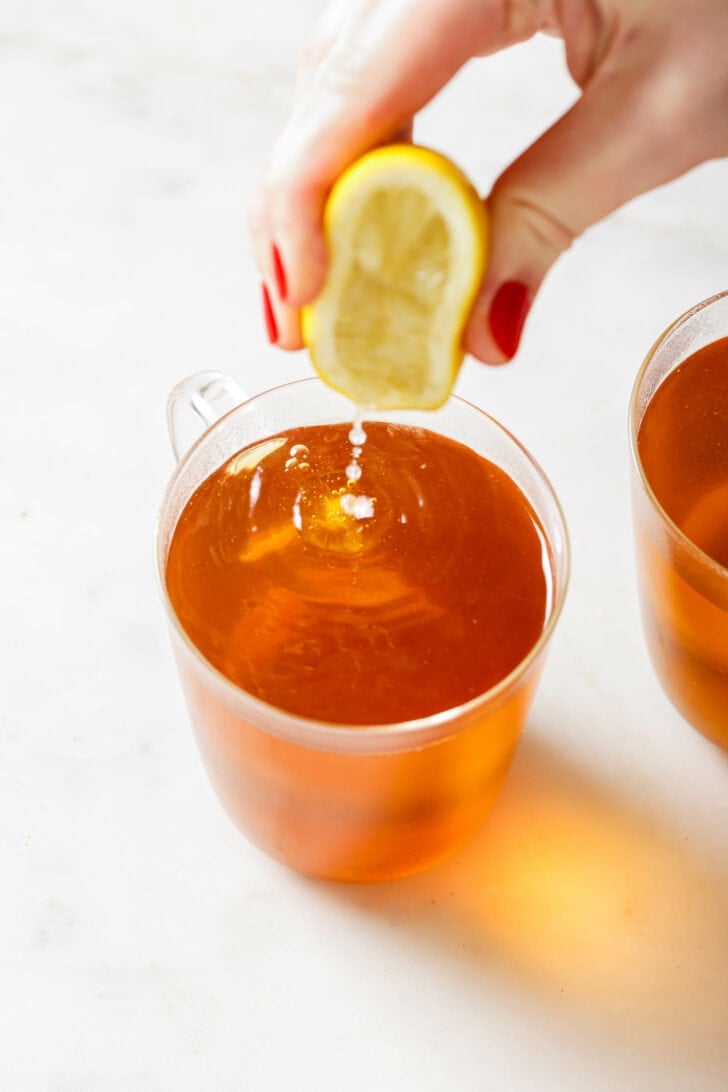
- If you’d like, sweeten with honey or other sweetener such as jaggery or maple syrup. Enjoy hot!
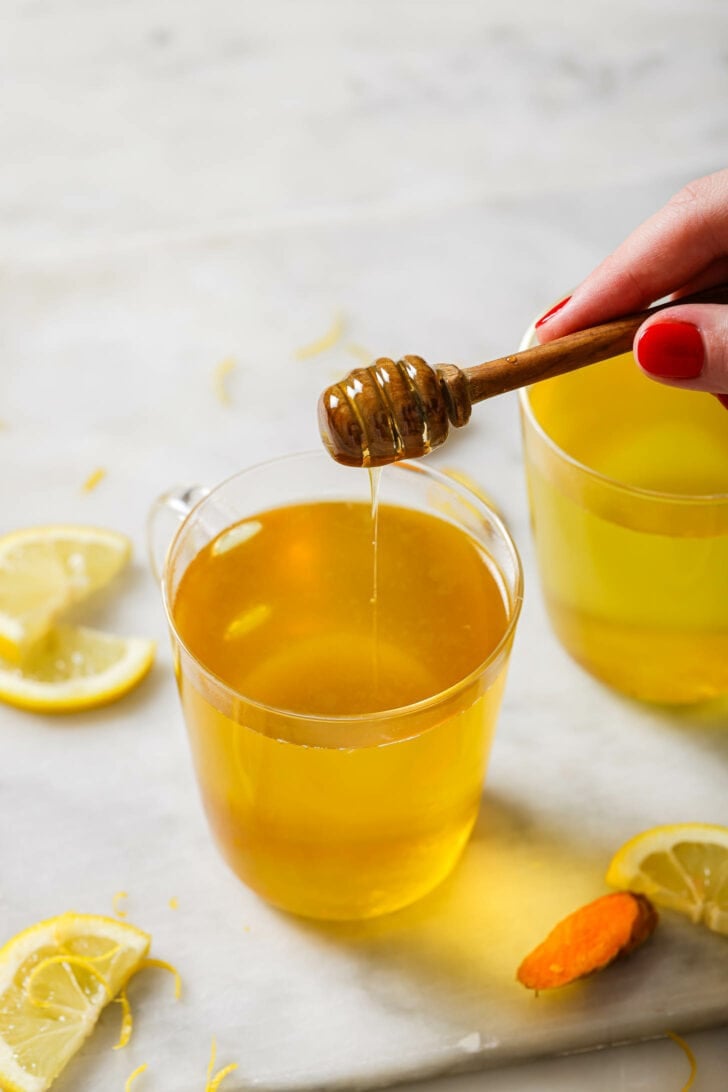
Flavoring Options/Variations
Since the ginger and turmeric is already quite pungent, I don’t feel the need to use whole spices like I would for Turmeric Milk or Masala Chai.
- Cinnamon: I have tried and love adding a cinnamon stick, which adds flavor and natural sweetness to the drink. Use no more than 1/2-inch broken piece of cinnamon as it can get overpowering.
- Spices: For a spiced version, add a green cardamom and clove along with the cinnamon.
- Orange blend: Lipton, Yogi, Trader Joe’s, and Rishi all use orange peel or or oil, which I think would be a lovely complementary citrus flavor.
- Add fat: As I mentioned earlier, because both piperine and curcumin are fat-soluble, turmeric absorbs better with a fat. I don’t add fat to this recipe simply because it doesn’t feel natural or appetizing to me. If you want to try it, feel free to add 1/8 teaspoon of a healthy fat such as coconut oil or ghee.
A Note on Turmeric’s Benefits
Full Disclosure: My expertise lies in taste, not nutrition, but I’ve linked several reliable (read .edu/.gov/.org) resources if you’d like to learn more:
- Turmeric has been used for centuries in Ayurvedic medicine as well as Traditional Chinese medicine.
- In a review of 700+ studies, turmeric was found to outperform many pharmaceutical drugs.
- The National Institutes of Health PubMed database listed nearly 5000 studies and articles on turmeric or curcumin (and that’s in January of 2015).
- Numerous studies have linked turmeric with a vast amount of immune-boosting, anti-inflammatory, and antioxidant properties.
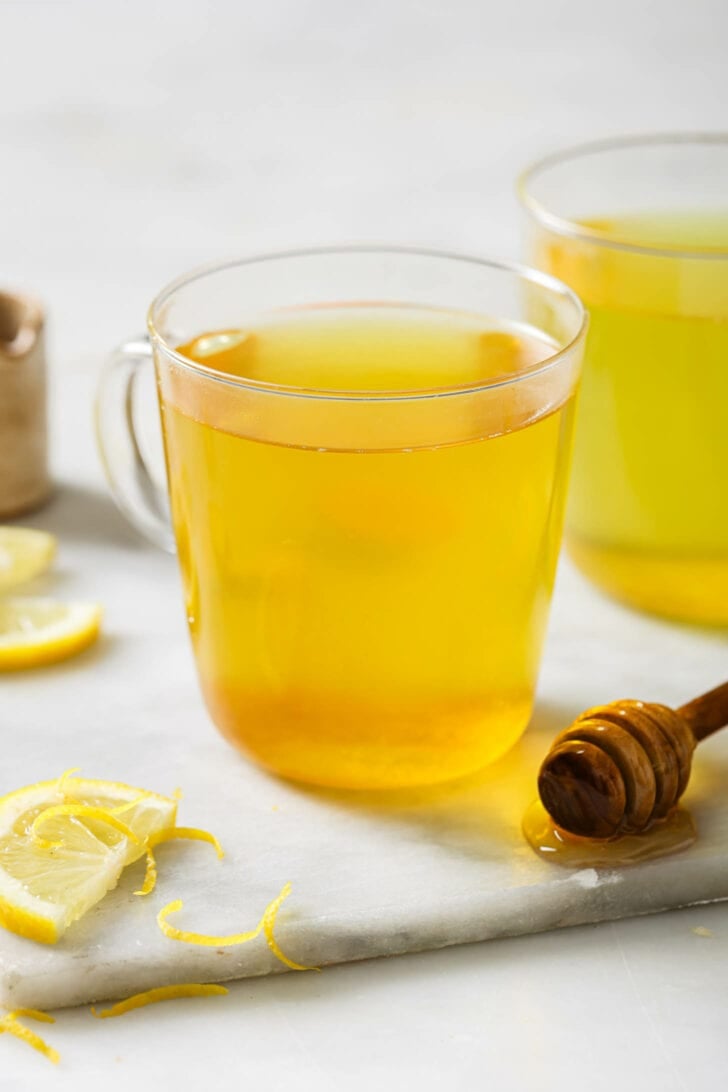
Tried this recipe? If you have a minute, please consider leaving a comment telling me how it was! If you have a photo of your dish, please feel free to upload it and share with others. If you’re on Instagram, please tag me so I can see your creations. I truly love hearing from you. Thank you!
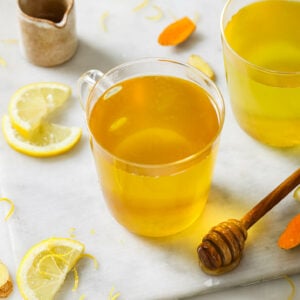
Turmeric Tea Recipe (with Ginger and Lemon) – Tastier than Tea Bags!
Watch the Video
Ingredients
- 2 cups water
- 1- inch (8 g) fresh turmeric root, washed and thinly sliced – no need to peel – Note 1
- 1/2- inch (4 g) fresh ginger root, washed and thinly sliced – no need to peel
- pinch (3-4 cracks) freshly ground black pepper
- 1/2 tbsp freshly squeezed lemon juice
- honey, optional – to sweeten
Equipment
- Saucepan
Instructions
- Pour the measured water into a small saucepan (Note 2) and bring to a simmer over medium-high heat. (I like to get the water started in my kettle.) Add the turmeric, ginger, and black pepper and stir.
- Reduce the heat to a medium-low, and simmer for 5-10 minutes, depending on how strong you’d like the steep.
- Strain the tea through a fine sieve into a cup. Squeeze in the lemon juice (the color will lighten). Sweeten with honey, if you’d like. Sip while it’s hot.
Notes
- Double the ingredients. Follow the recipe up to Step 1. On Step 2, simmer on medium heat for 25 minutes. You’ll be left with around 2 cups concentrate, 4 (1/2 cup) servings.
- Strain into a glass bottle or jar with a lid. Allow to cool. Cover and store in the fridge for up to a week.
- When ready to use, place 1/2 cup of the concentrate in a mug and microwave until hot (~45 seconds). Pour freshly-boiled water over it.
- Add lemon. Sweeten with honey, if you’d like.
- Heat approximately 1 1/2 cups water (depending on the size of your mug) in a tea kettle. Using less water = stronger flavors.
- While the water heats, place the turmeric, ginger, and black pepper in a large mug (preferably thick/heat-proof – you want the water to stay as hot as possible).
- Pour boiling water into the mug. Cover and allow to steep for 5 minutes.
- Strain the solids by pouring the tea through a sieve into another mug, or leave as-is if you don’t mind the ginger root in your tea.
- Squeeze in the lemon. Sweeten with honey, if you’d like.


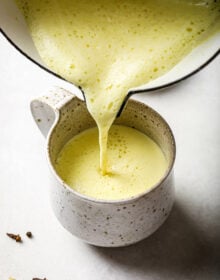
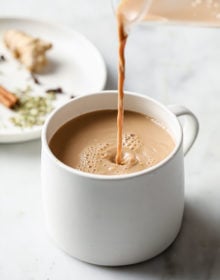
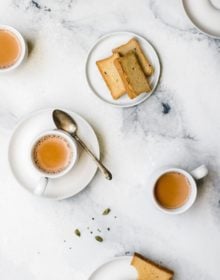

4 Comments on “Turmeric Tea Recipe (with Ginger and Lemon) – Tastier than tea bags!”
This was so easy to put together. I found it kind of spicy. Do I just cut back on black pepper to make it more mild?
Thank you for the feedback, Emma! Either black pepper or ginger could make it spicy. It could be that your pepper grinder’s cracks were more generous than mine. Do you think it could be one of these?
Thanks for your response! I cut down on the black pepper and ginger and that worked!
So glad to hear it. Thank you!